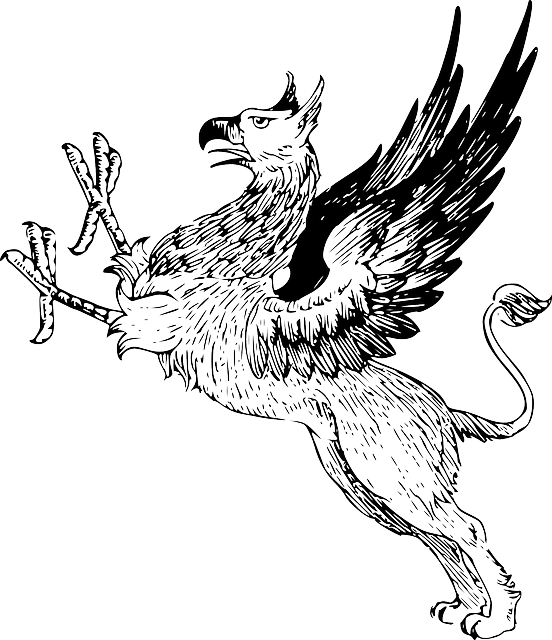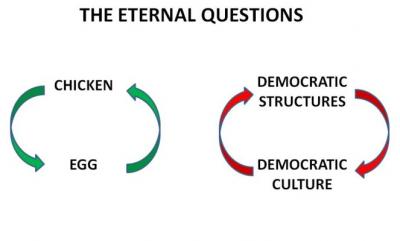
Why Not a "Strulture" that Combines Them?
"One cheer for democratic culture; another for democratic structure; three cheers when they join together in collaboration."
~Anonymous
 "Strulture”?
"Strulture”?
A new (or overlooked) relationship demands a new term: A “strulture” is a collaborative and mutually enhancing relationship between structure and culture. This relationship obtains, e.g., where:
A “democratic structure” (larger scale institutions and patterns of governance) and a “democratic culture” (attitudes and commitments at the local, grassroots, or inter-personal level) mirror each other, support and protect each other, and contribute to the overall accessibility, inclusiveness, growth, and strength of workplace/economic democracy.
Positive Examples
- Mondragon’s reconstruction of democratic membership to include being an “empressario”, or a developer of new cooperatives. (See "The Challenge of Mondragon" by George Benello and Caitlin Quigley's recent report from her trip to Spain)
- DAWN’s peer-2-peer program which enables grassroots practitioners to help shape the overall worker co-op community.
- The Lucas Plan, in which workers themselves, through identifying their own skills, passions, and aspirations, construct a fall-back new enterprise plan in case their current workplace becomes unsustainable.
- The former Yugoslavian system of “self-management” in which elected officials, in general, are “delegates”, readily recalled and required to continue working and/or residing, at least part-time, in the very communities or workplaces that elected them.
- The original Porto Alegre form of the participatory budget, in which public officials are required to enable citizens and citizen-driven organizations to shape how and where their tax revenues are used.
Negative Examples (where the absence of one undermines the other)
- El Pollo Criollo (EPC): Here a support organization (Federation for Economic Democracy, forerunner of the ICA Group) assisted laid off workers in taking over a defunct chicken processing plant using a genuinely democratic structure that gave them controlling numbers on the firm’s Board. But this structure, by itself, had nothing to offer them when EPC was forced to close due to underhanded competitive pricing by a multi-national chicken processing corporation. Why not? Because the workers had not been empowered to design ways to continue working together, or even separately, should their enterprise go under. A good structure was not enough.
- Central CT Middle School (not its actual name): In this case, a group of graduate and undergraduate students under my coordination convinced a middle school principal to allow us to facilitate study circle workshops with his seventh graders. These focused on enabling the younger students to discuss in a open and dialogical way what they were learning, to assess it, and make recommendations to improve or reshape their own classroom experience. It worked wonderfully well for over two years, but began to fall apart at the beginning of the next year. Despite the principal’s support, he had been overruled by a newly hired Superintendent, who decreed that subjects other than the core math, science, social studies, and English were to be verboten, as of the next semester. Hearing about this, the students became enraged at the loss of their art and music, as well as study circle courses, and many of them cut classes or became unruly in them.
In this case, we had managed to begin building a very close and empowering culture, one where the students could feel their own voices were heard and their talents appreciated. But we poured all our time and energy into that, and totally neglected the structural or larger institutional context, failing to reach out (until too late) to our students’ parents or to other teachers and teacher organizations to create allies. And, also, failing to look for potential support among outside allied organizations, such as Everyday Democracy – which is located in our state and had pioneered the use of citizen dialogue to resolve community problems – for assistance with the School District and its administration. We were blind-sighted institutionally, despite our astonishing success in building a democratic culture.
 Lessons? – and an Example
Lessons? – and an Example
Perhaps “culture” and “structure” are not invariably separate, contrasting, clashing, etc. If so, advocating that either one trumps the other might be better replaced by seeking “culture-enhancing structures” and “structure-enhancing cultures”.
We could try seeing the relationship here as analogous to that between the lyrics and melodies of a song. If one or the other is totally missing, you don’t have a song at all. If one is present but under-developed (schmaltzy or clichéd, for example), this weakens or degrades the whole song. And, if one overshadows or dominates the other, this will have the same result.
Beyond this, for a really great song, you need lyrics that resonate with, reinforce, enrich the melodies, and vice-versa. This is way more than merely fitting into the time spans or matching the sound strength (loud vs. soft) of one another. It calls for something akin to an art of collaboration.
One really fine example of this art is a process designed by poet, librarian, and writing mentor Wendy DeGroat, which she calls the “Kiva Feedback Ladder”. Though originally designed as a mentoring guide, I think it can be readily applied to a host of other situations, including ones involving conflicts between individuals, organizations, loyalties, ideologies, etc. As such, it could help turn aggressive antagonists into collaborative allies.
Wendy sent me a pdf version of her ladder (see below), which is adapted from other writing mentor guidelines, e.g., Harvard’s Project Zero. Here’s a question about it you might want to ask yourself: Shoud the Kiva Feedback Ladder be counted as an instance of “democratic structure”, or as one of “a democratic culture”; or should it rather be understood as a “democratic strulture” – playing a role in, and combining aspects of, both structure and culture?
Kiva Feedback Ladder for Creative Writing
Observe
Notice and name elements of writing craft. Describe what’s happening in the work without judging effectiveness/value.
Appreciate
Point out effective elements and explain their impact.
Clarify
Ask questions about elements that confuse or concern you.
Suggest
Share ideas you have for improving the piece.
Why a kiva ladder?
Kivas are underground rooms found in ancient Pueblo settlements. Often used for spiritual purposes, kivas feature a small, round indentation in the floor called a sipapu which some believe represents the earthen gateway through which their ancestors arose onto this land. Imagine descending a kiva ladder as you discuss a creative work. Begin by observing what’s on the surface, then deepen the analysis gradually, each rung of the ladder moving you closer to the work’s core.
What do observations sound like?
Resist adding judgments such as “I really liked that” or “that turned me off” to your observation. Notice, name, and summarize in a matter-of-fact manner.
- The poem is written in free verse and organized into four stanzas with six lines each. Images of light and brightness appear several times.
- In this story, two people argue about walking the dog, and while they’re arguing, the dog disappears.
- In the last paragraph, the point-of-view shifts from third-person to first-person. The first-person narrator sounds angry or bitter.
- Current action is written in present tense; flashbacks are written in past tense. In the escape scene, the sentences become much shorter.
- There are many long vowel sounds, mainly “o” sounds, in the description of the funeral. I also noticed four clichés.
What do appreciations sound like?
- The images of light and brightness created a joyous, almost reverent mood. I especially liked the vivid description of sunlight dappling the rocks.
- I could sense the speaker’s fear through vivid verbs like peered, crouched, and clutched.
- The short sentences in the escape scene heightened the suspense.
What do clarifications sound like?
- I’m confused about the age of the narrator. I thought he was a child, but his vocabulary sounded more like a teenager.
- Is the third paragraph part of the flashback?
- I got lost in that five-line sentence in the opening paragraph. I reread it, but I’m still not sure I understand it.
What do suggestions sound like?
- Consider leaving out the part about the parrot. It’s funny, but it distracts from the main point of your essay.
- Use more vivid verbs and sensory details to convey the anxiety and exhilaration the narrator felt as she climbed toward the diving platform.
- Try starting with the campfire scene; it would hook the reader right away. You can fill in the other details later.
- Loosen up the dialogue so it sounds more like a conversation.
Adapted by Wendy DeGroat (2012) from Anne-Marie Oomen’s feedback process (Solstice MFA, 2011) which was modeled on Daniel Wilson’s “Ladder of Feedback” (Harvard, Project Zero, 2005)
Note: In conversation with me, Wendy mentioned yet a fifth rung of her ladder, one where the person being mentored is offered the opportunity to ask her mentor questions, or in other ways become an active contributor to or shaper of the dialogue.
Go to the Scaling-Up the Cooperative Movement theme page
Go to the GEO front page
Citations
Len Krimerman (2014). Structure vs. Culture: Why Not a "Strulture" that Combines Them?. Grassroots Economic Organizing (GEO). https://geo.coop/story/structure-vs-culture

Add new comment